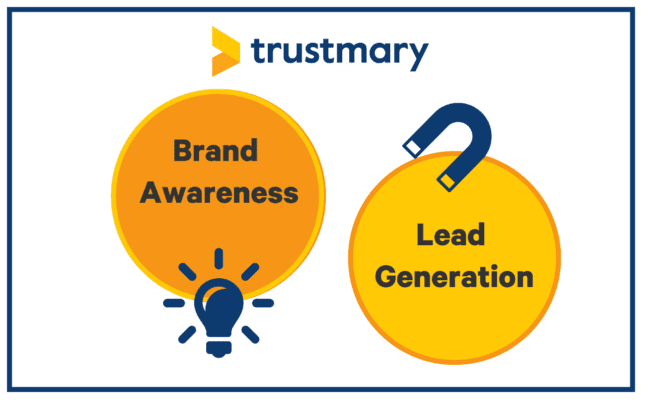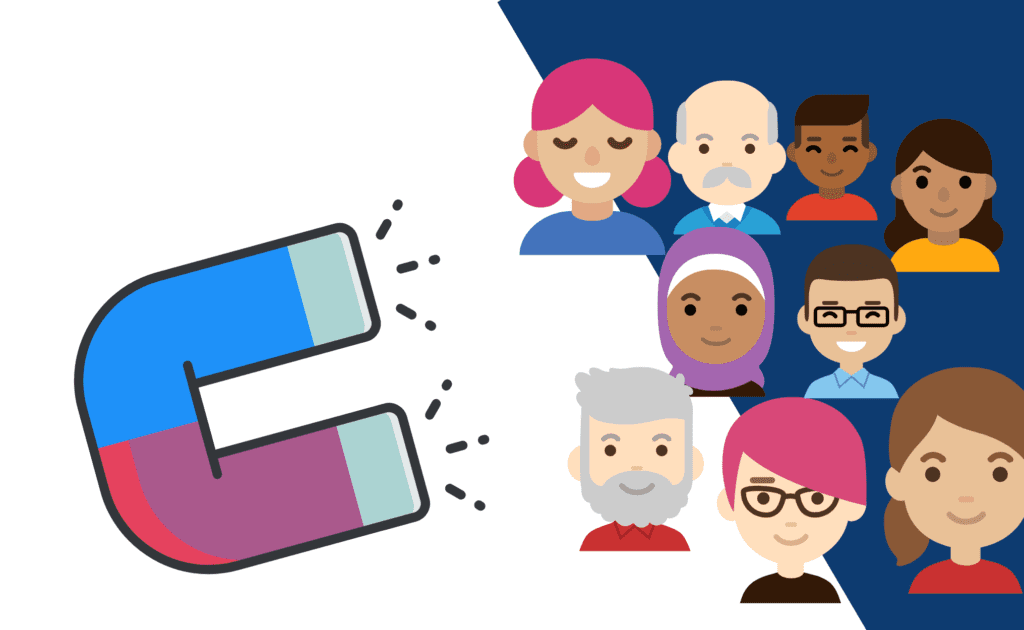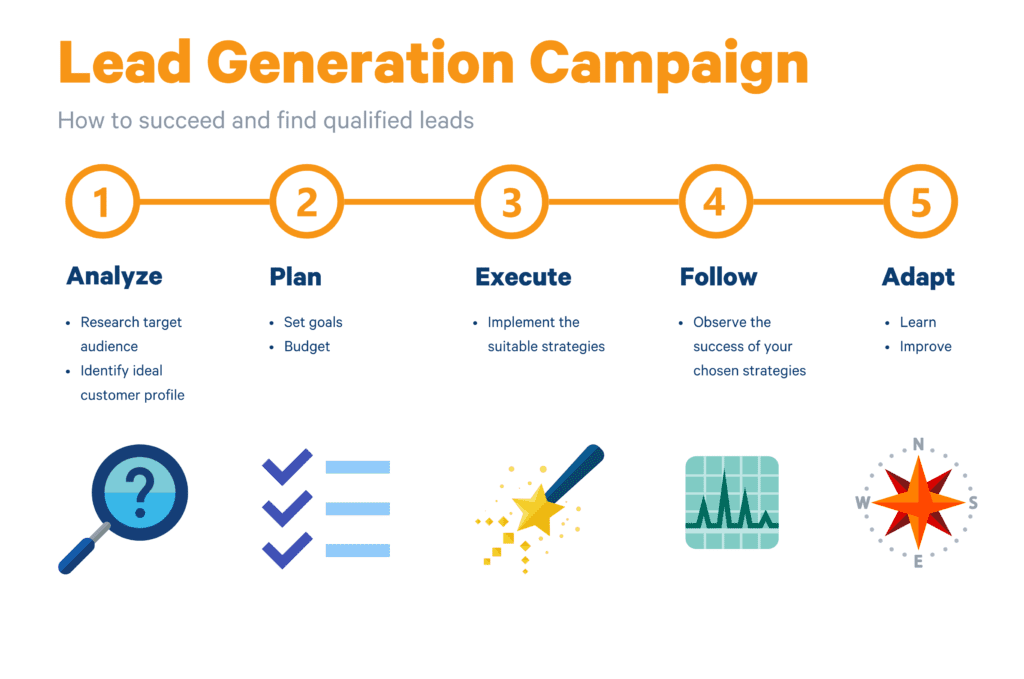Lead Generation Vs Brand Awareness: Where Should You Focus Your Efforts?


It can be a struggle for marketers to decide between focusing on lead generation strategy or brand awareness efforts.
And this can lead most organizations to treat the two strategies separately, when in fact, they could also be using them side by side.
Today we’ll run you through how brand awareness and lead generation differ, the right time to use each one, and how they can actually complement each other.
But first, in the battle between lead generation vs brand awareness campaigns, what’s the difference between the two?
Brand awareness and lead generation are not complete opposites but let's see how they impact website traffic and customer mindshare.
What Is Brand Awareness?
Let’s start with the definition of brand awareness.
- Used primarily to increase the size of your audience. You’re aiming to get your name known to as many people as possible;
- This can be through any form of broad advertising, social media campaigns, networking events, and promotions;
- You don’t need to make sales, just get people to recognize your name and brand and get them to see you as a trusted player in the market;
- This then lays the groundwork to follow up with a lead generation campaign.
In a nutshell – brand awareness is making people aware of your brand!
Simple, right?

Brand Awareness and Sales
Building brand awareness is a longitudinal process and will not necessarily result in increased sales very soon.
However, in the long run you might get more sales because:
- People recognize your brand. When they think about which brand to buy from, you pop to their mind.
- People are loyal to brands they love. Once you win people over and provide great service, they will return to you.
Neither of these benefits come easy, so you really need to fulfill the expectations!
If you can do that, you gain brand trust, which is powerful:
Think about e.g. Apple or Nike. There are people who always buy from these brands simply because they love the brand and view them as superior, which is why they are willing to pay a premium price.
When Should You Use A Brand Awareness Campaign?
A brand awareness strategy is all about getting people to recognize your brand and building trust with your audience.
It has some overlap with a general marketing campaign but it is distinct in its goals as it doesn't have a specific goal like selling the company's software or gathering contact information.
Try to think of brand awareness as the foundation of your brand, the shop window that draws people in.
It can be particularly useful in the following situations:
1. Starting A New Business
You’re an unknown quantity when you first start out, and the vast majority of your marketing budget should be spent on brand awareness if you are in a segment where lead generation straight away is not possible.
Tell people your story and entice the customers in.

2. Differentiating Yourself from Competitors
If you’re in a crowded market, a solid brand awareness campaign might be just what you need to stand out. For example, if you’re one of 10 sporting goods stores in your area, tell people why you’re different. What makes you special? Why is your brand better than everyone else?
3. When You’re Building Trust
People are more likely to buy from companies they trust. Try offering content like a regular blog post from time to time as branded content, an in depth white paper, videos (as they are both valuable content and can be used as gated content), and special offers to show how good your brand is on social media platforms.
Establishing widespread recognition is the goal here and that's why it is weird to put brand awareness vs lead generation as they basically help each other.
If you want to collect email addresses, get a response to a call to action, attracting attention through useful branded content can help your company get ahead in the boxing match with the competition.
Reaching ideal growth conditions is tied in with awareness strategies and every business knows that success goes hand in hand with awareness.
Brand Awareness Techniques to Try
Not sure how to create a brand awareness campaign?
Here are some ideas and examples you should give a go.
1. Talk About Values and Interests
If you want to have a strong brand, you need to be more than just your product or service.
Create a personality, interests, passions and values for your brand and reflect these consistently throughout your marketing and communications efforts.
Start discussions around the topics and themes that go along with your brand image.
Make written content, blogs, social media posts, white papers, guides and so on.
Don’t forget other mediums like video, podcasts and live events!
Values like sustainability and human rights are extremely important for the contemporary consumers.
2. Build A Community
Different online communities are a great way to engage with your customers and create a strong brand.
Plus, when you engage your community enough, they become great advocates for your brand on their own.
The advocates will share your content on social media and talk positively about your products and services – on top of being lucrative customers themselves!
How to do this?
All your brand awareness efforts will help you gather the community. All you have to do is provide a platform for them to interact on.
It can be a Facebook group, a blog, a Youtube channel or an Instagram hashtag. Whatever you come up with!
3. Advertise Smartly
Yes, you read it correctly. Advertisements are also a great way to build brand awareness. Brand awareness ads reach large numbers of people and let them know that you exist.
Just remember your personality and values, and reflect those in the advertisements.
Ads also offer an opportunity to reinforce and repeat your brand logo and slogan.
4. Collaborate
Collaborating with relevant people, organizations and events brings you to the attention of new audiences.
Try this:
- influencer marketing
- sponsor events
- sponsor athletes or local hobby groups
- donate to charity
- organize events with other brands and organizations
5. Be Recognizable
You must have something that people remember you from. That’s why the perfect logo, slogan and brand voice are essential.
Once you have recognizable features, apply them to everything you do: advertising, content, community, events, etc.
Over time, people will start connecting the specific sounds, words, colors or shapes with your brand.
What Is Lead Generation?
Now, let’s define lead generation.
A lead is someone (person or organization) that is interested in your product or service.
Compared to brand awareness, lead generation is a more concrete process which aims to get actual purchases and new paying customers:
- This is the targeting of a customer base for a specific purpose;
- Your goal is to get people to specific landing pages, purchase a product or sign up to an email list;
- It’s easy to measure the success of your campaign using metrics.
Lead generation can be done with a plethora of different tactics, and it depends on how aware your potential customer is about your brand which types of tactics you should use.
If you have already created good brand awareness, the chances are that your leads are already warm (=know about you and proactively reach out to you) and you can use inbound marketing tactics.
Sometimes your leads are cold, which is why you need to contact them yourself and use outbound marketing strategies.
Now that we look at the above list, some of the tactics also work for creating brand awareness. In some cases, lead generation and brand awareness generation cannot be separated from each other.
Lead generation process includes not only the reaching of potential customers, but also lead qualification: defining which leads are the most lucrative and which are not yet quite ripe for sales and need more nurturing.
Read more about lead generation for:
When Should You Use Lead Generation Campaigns?
Once you’ve got a customer’s attention with brand awareness, now is the time to offer them something of value and make a sale, this is the heart of generating leads.
All companies should be running regular lead generation campaigns, but are very useful in the following situations:
1. Building Your Email Contact List
Email marketing is still one of the most popular (and valuable) forms of marketing, with one of the highest returns on investment. Every company should use lead generation to build a large and profitable list. Try advertising discounted offers in exchange for customers signing up to your mailing list.

2. Getting Referral Sales
Using your existing customer base as a source of referrals is another excellent type of lead generation. This is especially effective for local businesses that can referrals from friends and family in your area.
3. Companies that Operate in A Niche Market
Lead generation is vital in niche markets, given the smaller customer base. You might want to consider lead generation techniques like adding newsletter sign-up options to your social media campaign or using targeted Google ads—your marketing strategy in general.
The buyer's journey to your landing page is much easier with lead generation efforts and improving brand awareness boosts your marketing efforts. These are specific techniques to generate leads so use them when you need to.
Using awareness and lead generation as your brand's foundation to reach that industry thought leader status which makes reaching potential customers as many impressions usually mean many potential leads.

Lead Generation Techniques to Try
Here are 5 techniques you can adapt to your lead generation campaign.
1. Find Leads with Online Tools
Did you know that there are a plethora of online tools for finding leads?
These tools can find email addresses, include a B2B database, or identify anonymous website visitors.
There are free as well as premium plans available.
Check out the lists of best tools for lead generation and lead generation websites that we have compiled.
2. Digital Word-of-mouth
As stated earlier, happy customers are your biggest advocates and can help you get more leads and customers.
Give your happy customers an easy way to recommend your products and services.
Try Trustmary’s testimonial, review and video testimonial tool for free!
You get a survey tool that helps you collect feedback from your customers and make them into testimonials that are showcased on your website and social media.
3. Chatbots
Chatbots are great for lead generation. They are available 24/7 for your busy leads and they can have multiple roles in the customer experience.
They help not only with capturing leads (=collecting contact information), but also with lead qualification.
You can script the right questions for your chatbot to ask. These questions can help you determine whether you have a qualified lead in your hands.
In the future, chatbots will be more and more powered by AI, which will make them even more handy.
Trustmary also offers a fully customizable chatbot template.
4. Lead Generation Forms and Popups
Lead generation forms and popups function similarly to chatbots, but are not as conversational.
They offer an easy way for your potential clients to leave their contact information.
This way the potential clients can let you know that they want you to contact them.
5. Gated Content
Gated content is valuable content that is only available to people who hand in their contact details.
The content can be e.g. white papers, videos, podcasts or newsletters.
Give your audience a small snippet of content so that they can decide whether they are interested in it. After that, show a popup or CTA that requires them to submit an email address.
After submitting the address, they get full access to the content.
Why Every Company Should Use A Combination of Both
Remember, it doesn’t always have to be a case of lead generation vs brand awareness, and your best strategy is to combine the two for effective results.
Don't make your business just focus on one, they go hand in hand in terms of overall marketing strategies.
The important thing is to implement the right technique at the right time as both can be good for generating leads and moving your brand forward. Always think of it as a two-stage process:
- First, build a trustworthy reputation through a brand awareness campaign;
- Then, make good on your reputational claims by offering something specific of value through lead generation.
Brand awareness and lead generation go together and are not mutually exclusive.
In fact, they often overlap, and brand awareness can be thought of as the first step in lead generation. Brand awareness is also a broader concept that creates customer loyalty and makes your brand stand out from the competition.
So, to answer the initial question of where you should focus your efforts: both!
Reaching your prospective customers through good brand awareness work will give you enough visibility and lead generation activities will help reach that target market and get it into your sales funnel.
This means more precise audience segments, more leads, fewer cold calls, more leads, and inceresed number of new customers.
Follow these two steps and you’ll start to see your advertising efforts paying off in no time and your sales team will love it! Use these two at the same time and many visitors will find your business!
Next Steps
How to start generating leads and brand awareness easily?
One thing that you can do right now is sign up for a free trial at Trustmary.
You get unlimited testimonials, video testimonials, and importing existing reviews to your website.
Trustmary helps you collect customer feedback and endorsements from the happy customers.
That is the first step to building trust and credibility for your business.
FAQ
What is brand awareness vs lead generation?
Brand awareness is the process of creating awareness, recognition, reputation and trust for your brand. Brand awareness distinguishes your business from competitors. Lead generation is a process of finding potential customers with different tactics. These two processes overlap and are both important parts of your overall marketing strategy.
How to generate brand awareness?
First you need to determine the personality of your brand. It includes values, interests and passions, as well as the look and voice of your brand. After that you need to communicate these aspects in marketing and communications.
How to run a brand awareness campaign?
When you run a brand awareness campaign, you must understand that it is not a sprint, it’s a marathon. Brand awareness is difficult to measure, but you will eventually notice that a successful campaign generated more sales and positive sentiment. Be patient and consistent.
What is brand awareness vs reach?
Brand reach is quantitative: it’s a number of people who see and hear about your brand. Brand awareness is more difficult to measure, but these two concepts are very close to each other.
What is the purpose of branding and lead generation?
When your branding and brand awareness are strong, lead generation becomes easier as people can find you by themselves. They know your brand’s name already and can e.g. google you and follow you on social media.